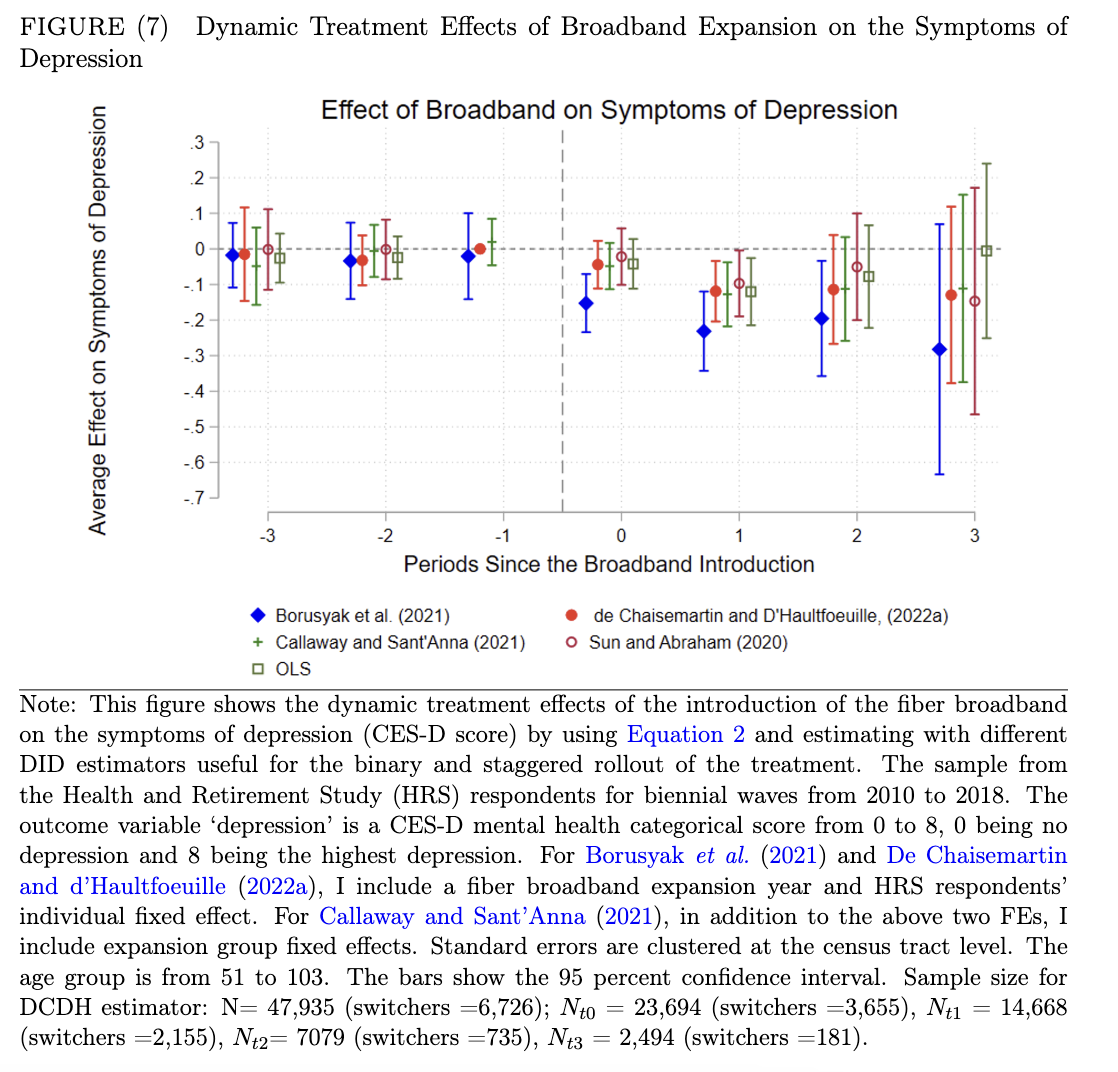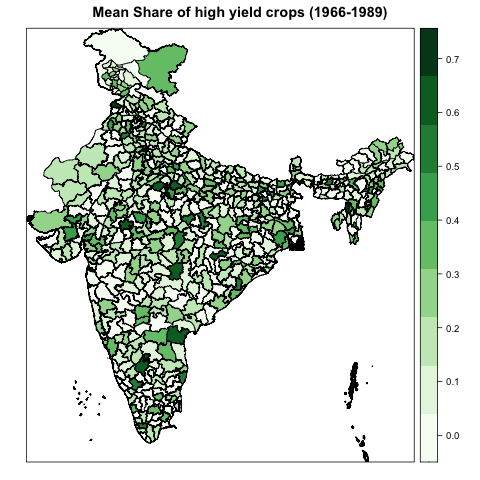Publications
- Early-Life Economic Conditions and Old-Age Mortality: Evidence from Historical County-Level Bank Deposit Data with Valentina Duque, Jason Fletcher, Hamid Noghanibehambari, Lauren Schmitz (Journal of Population Economics, January 2024)
- Discrimination in Science: Wage Gap between US and Foreign-Born Land Grant Scientists with Jeremy Foltz (Forthcoming, 2025 (American Journal of Agricultural Economics (AJAE)))
-
Is there a Link between Access to Broadband and Health Outcomes? A Spatial Econometrics Approach with Steven Deller (American
Journal of Economics and Sociology (2024) )
- Effect of Preventive Health and Health Services (PHHS) Block Grant on the Performance of the State Public Health Departments, with Sergey Sotnikov and Nancy Habarta
- Systematic Review of the Literature on the Effects of Public Infrastructure Investments and Health Outcomes, with Sergey Sotnikov and Nancy Habarta
-
Does High-Speed Internet Access Affect the Mental Health of Older Adults? (Presentations- MEA ’23, American University-’23, SEA ’23, APPAM ’23) (Popular Media Highlight: GROW Magazine Cover Story)
Abstract: Recent research has shown the negative effects of the internet on younger people’s mental health. Yet, we do not know whether the same effects are present among the older population, who are especially vulnerable to certain mental health conditions and more likely to fall victim to online deception. I estimate the effect of broadband availability on the mental health of the 50+ age group in the United States from 2010 to 2018. I use individual panel data and exploit quasi-experimental variation induced by the staggered rollout of broadband at the census tract level using the latest difference-in-differences (DID) framework. Despite evidence of the internet’s harmful effects on younger populations, I show that broadband rollout significantly improves older adults’ mental health, reducing depression symptoms by 5.7%. Key mechanisms driving these positive gains include a decline in feelings of social isolation and loneliness and an increase in the quality of virtual social connections. Whites, rural dwellers, women, and married individuals appear to be the biggest beneficiaries of broadband’s positive effects on mental health. This work highlights broadband’s unmeasured additional benefits to public investments, given the recent allocation of over $65 billion to broadband expansion.
-
Effect of Early Life Exposure to the Green
Revolution on Aging Outcomes in India with Lauren Schmitz, Valentina Duque, Jinkook Lee, Hunter Green, (presented at APPAM)
Abstract: The Green Revolution is the most significant shock to agricultural productivity gains that substantially improved economic outcomes in developing nations. However, its long-term impact on aging-related outcomes is not well understood. We examine how early life exposure to the Green Revolution affects later life physical and cognitive health outcomes using the Longitudinal Aging Study in India (LASI). We find that exposure to the Green Revolution from the in-utero period to age 2 significantly improved later-life cognitive function, especially among socially disadvantaged groups (lower Castes) and people born in rural areas. Specifically, a one standard deviation increase in exposure to the Green Revolution in early life improved later-life cognitive function by 0.054-0.123 standard deviations. Significant improvements in schooling and financial conditions in childhood partially explain positive gains in cognitive health. Using the universe of school data, we rule out the possibility that school construction was driving positive gains in schooling as well as the possibility that improvements in height were driving the benefits in cognitive function. These findings have important modern policy implications, as many developing countries are in the early stages of adopting the Green Revolution, but they will face a more significant aging population in the coming years than the global average.

-
Does Broadband Technology Affect Social Security Applications?
(Competitive grant from Retirement and Disability Research Center (RDRC) Center for Financial Security (CFS), Social Security Administration (SSA), Podcast Interview))
Abstract: One of the key focal reseach area of SSA is to understand the structural barriers for the Social Security Disability Insurance (SSDI) in the US. It is, however, unclear whether high-speed interent (braodband) technologies affect an individual's likelihood of receiving Social Security Disability Insurance (SSDI). This paper evaluates whether availability of broadband affects the enrollment in SSDI among the older adults. I leverage the quasi-experimental staggered rollout of high-speed broadband, combined with restricted individual panel data of the Health and Retirement Study (HRS), and exploit spatial, temporal, and individual variations in broadband availability. Employing the advanced difference-in-differences (DID) estimator to capture the dynamic treatment effect, I find an increase in the probability of receiving SSDI following the introduction of high-speed broadband. Heterogeneity analysis suggests benefits for rural areas. The estimates from this paper are crucial to prioritize the resources for the low broadband regions and households without access to sufficient broadband connections.
-
Spillover Effects of a Bicycle Policy on Girls’ Enrollment in Middle Schools
(Recognition under Best Paper Scholarship (Honorable mention), Dept. of Economics, UW-Madison, 2018)
Abstract: Distance to school and safety are two major challenges for the educational gender gap in developing countries. Numerous programs were introduced to address this concern in different parts of the world; however, less attention has been paid to understanding the spillover effects of those policies. This study examines the spillover effect of a grade-9 girls’ bicycle program on grade-6 girls’ enrollment in Bihar, India. I use the universe of administrative school-level data and employ a difference-in-differences approach. I find a statistically significant increase by 7.4 percent in the 6th-grade girls’ enrollment after the bicycle policy was introduced. Further, using a triple difference approach, I find the increase in enrollment is more significant in the schools that have girls’ toilets than the schools that do not have girls’ toilets. I also find that the increase in enrollment is lower for the girls who belong to socially disadvantaged groups. Using quantile regression, I show that the policy’s effect varies across the school’s size, increasing enrollment for the more prominent schools. Overall, this study sheds light on the underexplored impact of the bicycle policy on girls’ schooling preferences, emphasizing the potential benefits of combining bicycle programs with school infrastructure policies to narrow the educational gender gap.
-
The Effect of Teacher Hiring Policy on Student Test Scores: A Multiple Regression Discontinuity Design Approach for one of the Largest Public Schooling in the World
(selected at American Education Finance and Policy conference)
Abstract:The economic literature on the impact of class size on student achievement has mixed evidence. However, the majority of this research has been conducted in high- income countries or small-scale settings. This study contributes to the literature by ex- amining the impact of a minimum pupil-teacher ratio (PTR) policy on student achieve- ment in rural India, where multi-grade teaching is common, with one or two teachers instructing multiple grades in one or two classrooms. The PTR policy created several thresholds for the total number of primary school children, requiring the hiring of an additional teacher beyond each of these thresholds. Using a multiple regression dis- continuity design (MRDD), this study finds that the PTR policy led to some increase in the number of teachers in primary schools at a major threshold. This increase in teachers was associated with a small but significant improvement in student test scores in Mathematics and Reading. These findings suggest that reducing class size through a PTR policy can be a cost-effective way to improve student achievement in rural India, a context where educational resources are often scarce. -
Effect of Green Revolution on the Intergenerational Human Capital
with Valentina Duque and Lauren Schmitz -
Spatially Varying Gender and Caste Inequalities in Cognition and the Contribution of Individual and Statelevel Characteristics Across India
with Lauren Schmitz, Kanika Arora, and Shubhashrita Basu
CDC Research
Working Papers
Selected Work In Progress